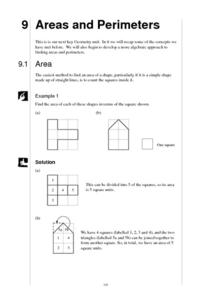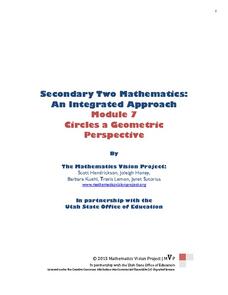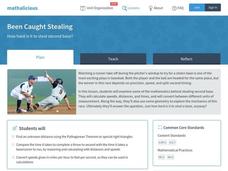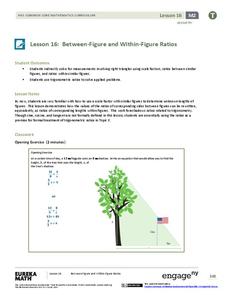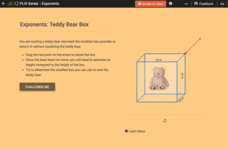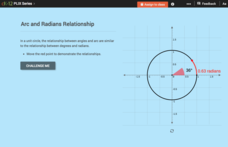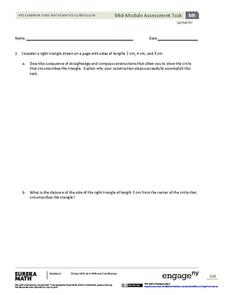Noyce Foundation
Which is Bigger?
To take the longest path, go around—or was that go over? Class members measure scale drawings of a cylindrical vase to find the height and diameter. They calculate the actual height and circumference and determine which is larger.
EngageNY
End-of-Module Assessment Task - Geometry (module 1)
Have you hit a wall when trying to create performance task questions? Several open-ended response questions require a deep level of thinking. Topics include triangle congruence, quadrilaterals, special segments, constructions, and...
Centre for Innovation in Mamatics Teaching
Areas and Perimeters
Cover some serious area in your geometry curriculum with this collection of worksheets. After first introducing the concept of area using the tiling method, this resource continues on to teach learners how to use the area and perimeter...
Mathematics Vision Project
Circles: A Geometric Perspective
Circles are the foundation of many geometric concepts and extensions - a point that is thoroughly driven home in this extensive unit. Fundamental properties of circles are investigated (including sector area, angle measure, and...
Curated OER
Expressing Geometric Properties with Equations
Algebra and geometry are not interchangeable. Demonstrate why not with a series of problems that deal with the equations of circles and equations of lines that meet specific criteria.
Mathalicious
Been Caught Stealing
You're safe, when calculating the odds of stealing second base! Learners compare the rate of a runner to the distance the ball travels, in a lesson that explores right triangles and measurement. Full of discussion questions and fun...
Scholastic
Study Jams! Perimeter
Follow this engaging slide show on the calculation of polygon perimeter with some hands-on measurement of perimeters to solidify the concepts. On this webpage there are interactive assessment questions and links to related resources by...
EngageNY
Dividing the King’s Foot into 12 Equal Pieces
Apply, apply, apply! A measurement lesson plan applies a number of concepts to help learn a new construction. Scholars learn to divide a segment into n equal parts using a method that uses the Side Splitter Theorem and a method that...
EngageNY
Looking More Carefully at Parallel Lines
Can you prove it? Making assumptions in geometry is commonplace. This resource requires mathematicians to prove the parallel line postulate through constructions. Learners construct parallel lines with a 180-degree rotation and then...
EngageNY
Between-Figure and Within-Figure Ratios
Tie the unit together and see concepts click in your young mathematicians' minds. Scholars apply the properties of similar triangles to find heights of objects. They concentrate on the proportions built with known measures and solve to...
EngageNY
How Far Away Is the Moon?
Does the space shuttle have an odometer? Maybe, but all that is needed to determine the distance to the moon is a little geometry! The lesson asks scholars to sketch the relationship of the Earth and moon using shadows of an eclipse....
EngageNY
The Inscribed Angle Alternate – A Tangent Angle
You know the Inscribed Angle Theorem and you know about tangent lines; now let's consider them together! Learners first explore angle measures when one of the rays of the angle is a tangent to a circle. They then apply their newfound...
EngageNY
Proving the Area of a Disk
Using a similar process from the first lesson in the series of finding area approximations, a measurement resource develops the proof of the area of a circle. The problem set contains a derivation of the proof of the circumference formula.
CK-12 Foundation
Whole Number Exponents: Teddy Bear Box
Five questions—multiple-choice, fill in the blank, and discussion—make up an interactive that challenges scholars to mail a teddy bear using the smallest box possible without squishing it. A box with movable sides allows mathematicians...
CK-12 Foundation
Add and Subtract Decimals with Front-End Estimation: Wooden Beams
A six-question interactive tasks mathematicians to solve addition and subtraction problems using front-end estimation. Question types consist of multiple-choice and true or false. A set of wooden beams that can be measured using moveable...
Scholastic
Study Jams! Construct Angles
Practice those protracting skills while watching the step-by-step guide on the correct way to use this angle measuring tool. The resource follows with assessment questions testing their ability to understand and use the protractor...
CK-12 Foundation
Length of an Arc: Pi Hour
What time is it when the arc length is pi? An interactive displays the measure of the angle created between the hour and minute hand of a clock. Pupils can set the clock to different hours and calculate the arc length based upon the radius.
CK-12 Foundation
Conversion between Degrees and Radians: Arc and Radians Relationship
How are arc lengths and radians related? An interactive resource demonstrates the relationship as pupils create arc lengths in a unit circle and compare them to the angle measurements. Questions ask individuals to build upon this...
CK-12 Foundation
Properties of Multiplication in Decimal Operations: Balloon Animals
Commutive and associative properties are the focus of a five-question interactive. Dealing with decimal multiplication and addition, mathematicians solve multiple-choice and true or false questions using a model that moves balloons along...
CK-12 Foundation
Area and Volume of Similar Solids: Similar Solids
Five questions make up an interactive designed to boosts knowledge of area and volume of solid figures. Question types include multiple-choice, true or false, and fill-in-the-blank. A scale model changes measurement to provide a visual...
Curated OER
Triangle's Interior Angles
Given a pair of parallel lines and a triangle in between, geometers prove that the sum of the interior angles is 180 degrees. This quick quest can be used as a pop quiz or exit ticket for your geometry class.
K-5 Math Teaching Resources
Angles Template
Young mathematicians learn to see geometry from different angles with this simple printable resource. Providing multiple visual examples of angles, this simple document can be used as an instructional tool, a skills practice exercise, or...
EngageNY
End-of-Module Assessment Task - Geometry (module 2)
Increase the level of assessment rigor with the test of performance tasks. Topics include similar triangles, trigonometric ratios, Law of Sines, Law of Cosines, and trigonometric problem solving.
EngageNY
Geometry Module 5: Mid-Module Assessment
How can you formally assess understanding of circle concepts? Pupils take a mid-module assessment containing five questions, each with multiple parts.
Other popular searches
- Measurement and Geometry
- Measurement Geometry
- Measurement Geometry Defined
- Geometry/measurement Pre Test




